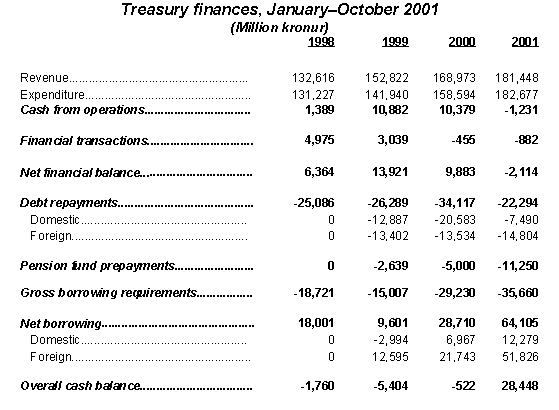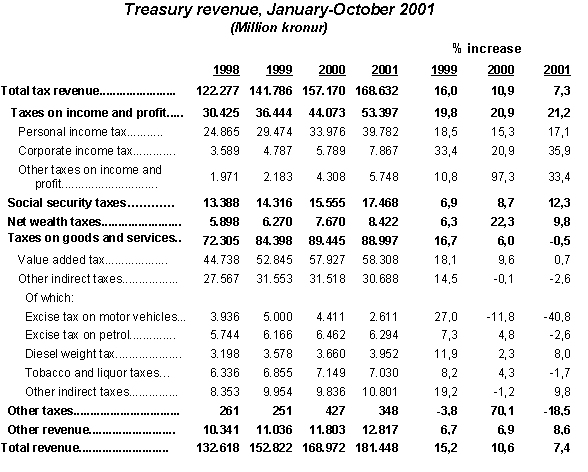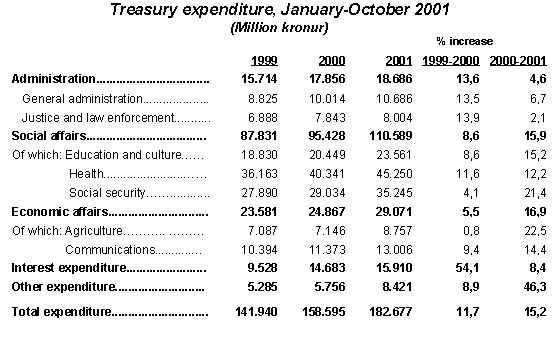Treasury finances in January - October 2001. Report date: November 21, 2001
Treasury Finances, January-October 2001
Report date November 21, 2001
This report is available in PDF form (PDF 25K)
Figures for Treasury finances in the first ten months of the year 2001 are now available. They are presented on a cash basis and are therefore not comparable to the Treasury accounts or the fiscal budget, both of which are presented on an accruals basis.
Summary
The cash deficit from operations amounted to 1.2 billion kronur in the first ten months of the year, compared to a surplus of 10.4 billion kronur a year ago.
Total revenue increased by close to 12.5 billion kronur from last year, due mostly to an increase in income tax collection. The increase in expenditure was considerably larger, and amounted to about 24 billion kronur or roughly 15%. The largest part of the increase is due to the impact of wage agreements and the development of the exchange rate, or about 6 billion kronur. In addition to the aforementioned, payments to the newly created Childbirth Leave Fund caused an increase of 2 billion and the increase in payments to the Municipal Equalisation Fund also amounted to 1.8 billion. The rise in interest payments amounted to 1.2 billion and special payments to the disabled to 1.3 billion. Payments by the Treasury to the Social Security Administration on account of increased pension payments amounted to 1 billion and 0.8 billion were spent on the purchase of farm production quotas. It should be noted that a part of this increase will not affect this year's accounts on an accruals basis.

The net financial deficit amounted to 2.1 billion kronur, close to 12 billion kronur below the result for the corresponding period a year earlier. A partial explanation of this is that in the year 2000, 5.5 billion were paid due to the sales of state banks in 1999. A total of 10.5 billion kronur were paid to the Government Employees Pension Fund in the first ten months of this year. The purpose of this is to reduce the Treasury's future commitments to the Fund.
Revenue
The Treasury's total revenue amounted to over 181 billion kronur in the first ten months of this year. The increase from last year is 12.5 billion kronur, or 7.4 per cent. Tax revenue has increased by a similar percentage, compared with 11 per cent last year and 16 per cent two years ago.

The increase in revenue from last year is largely due to an increase in personal and corporate income taxes as well as in capital income taxes. There are, however, some temporary factors leading to this outcome, the effects of which will subside in the next few months. For example, the increase in personal income tax revenue is largely due to a wage increase based on wage agreements in 2000 plus an additional increase in 2001. In total, taxes on wages and profits and social security taxes are close to 8.5 billion kronur above projections. Net wealth taxes are 300 million kronur above projections.
The slowdown in the economy is clearly reflected in the development of indirect taxes. Revenue from indirect taxes is S billion kronur lower than in the corresponding period last year and more than 6 billion kronur below projections. This development reflects a considerable contraction in real terms, or by 6 per cent. This is mostly due to a substantial decline in private consumption, especially vehicle purchases and other consumer durables such as household appliances. Excise taxes on motor vehicles have declined by 40 per cent, or by 1.8 billion kronur. Excise taxes on petrol have also declined, by 2.6%. The slowdown is also reflected in declining revenue from the value-added tax, which has declined in absolute terms from the previous year and by about 5 per cent in real terms.
All in all, total revenue for the first 10 months of the year 2001 amount to a surplus of approximately 2.5 billion compared with the budget estimate.
Expenditure
The Treasury's total expenditure amounted to close to 182.7 billion kronur in the first ten months of the year. Expenditure increased by 24 billion from last year due to several reasons listed in the summary above.

Administrative expenditure increased by more than 800 million kronur, or 4.6 per cent from last year. This is due mostly to a purchase of new information systems for the government at a cost of 450 million kronur, but foreign affairs expenditure have also increased by 440 million since last year, or a corresponding 17 per cent. Offsetting this to some degree is a decline in other expenses by 400 million kronur due to the fact that last year's expenditure included non-recurring expenditure connected with the Christianity millennium celebrations. Total law enforcement expenditure increased by only 2 per cent despite an increase of 700 million kronur in expenditure on police services and the courts, since payments for avalanche prevention measures declined by 750 million.
Social affairs. Close to 60 per cent of expenditure over this period went to various social affairs, including education, culture, health and social security. Expenditure in this category rose by 15.2 billion kronur from the previous year. Expenditure for education rose by 2.6 billion kronur, a substantial part of which is due to the increase of 400 million kronur in payments to the Student Loan Fund. It is foreseen that the Fund's loans will increase in excess of projections because of the decline in the krona exchange rate. Payments to the University of Iceland increased by 330 million kronur and payments to higher education and special schools rose by 1.2 billion kronur or 19 per cent which is partly explained by overtime payments to teachers following the teacher's strike at the secondary school level and subsequent pay increases according to new wage agreements. Expenditure on cultural affairs increase by about 500 million kronur.
Health expenditure increased by 4.9 billion and amounted to 45.3 billion kronur. Of this increase, 2.9 billion is due to increased operating expenditure of hospitals. 6.2 billion is explained by payments to the Social Security Administration, an increase of 21.4 per cent. Pension and disability payments increase by 2.9 billion, of which 1.3 billion is due to the Supreme Court verdict which raised disability payments. In addition, the amendments to the Social Security Act led to increased expenditure. The newly passed Childbirth Leave Act has led to an expenditure increase of 2.040 million kronur so far this year. Payments to the Unemployment Insurance Fund increase by close to 220 million kronur.
Economic affairs. Expenditure in this category increased by a total of 4.2 billion kronur, which is a 16.9 per cent increase from last year. Expenditure on communications increased by 1.6 billion, of which 1.1 billion went to road-building and maintenance and 60 million to harbours. Special items included government purchases of farm production quotas at a cost of 800 million kronur.
Interest expenditure increased by 8.4 per cent or 1.2 billion kronur. This is largely due to the decline in Icelandic krona exchange rate - interest payments on foreign debt have increased by 1.7 billion kronur. Interest payments on domestic government debt is practically unchanged from last year.
Other expenditure increased by 46.3 per cent or 2.7 billion kronur for two reasons. The first is a 1.8 billion kronur increase in the contributions to the Municipal Equalisation Fund, the second is a 700 million kronur increase in payments to the Government Employees Pension Fund.
Capital transactions
The outflow on the account of financial transactions amounted to a negative 0.9 billion kronur in the first ten months of this year, compared to a negative inflow of 0.5 billion for the same period last year.
Repayments of Treasury debt amounted to 22.7 billion, nearly all due to the repayment of a foreign government loan. A large domestic bond issue from 1990 matured in February and the redemption amounted to 9 billion kronur, of which 5 billion were repayments of principal, the remainder being accumulated interest. Furthermore, three domestic government bond issues were redeemed before maturity through a purchase auction for 4 billion, of which 2.4 billion were repayments of principal. Auctions of this kind are directed towards government bond issues that lack liquidity in the secondary market.
The Treasury remitted 11.3 billion kronur to the Government Employees Pension Fund, compared to 5 billion in the same period a year ago.
Treasury borrowing amounted to 64.1 billion kronur, 26.8 billion of which was borrowed abroad in order to refinance earlier foreign debt. Domestic Treasury bills outstanding increased by 6 billion in the first ten months of the year. In addition, new government bonds with a 6-year maturity were sold for about 6.1 billion kronur.
